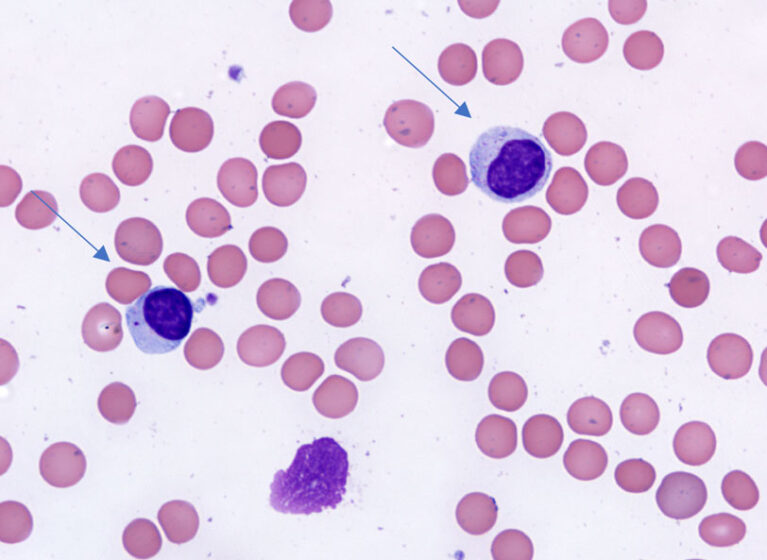
A team of researchers from UVA Health has completed the most extensive paired exome and transcriptome study of large granular lymphocyte (LGL) leukemia. They found that STAT3-mutated patients have increased mutational burden and neutropenia, whereas select STAT3-actviating mutations are associated with anemia. The findings provide evidence that screening for STAT3 mutations will help better classify and diagnose patients with the disease.
Study Led by a Pioneer in the Field
This well-publicized study was published in Blood. The journal dedicated a podcast and invited commentary on the study's findings, in addition to providing an associated CME credit opportunity.
The study's principal investigator, Thomas P. Loughran Jr., MD, is director of UVA Cancer Center. He discovered LGL leukemia in 1985, identifying it as a rare disease characterized by a clonal expansion of LGL cells. These cytotoxic cells cause rheumatoid arthritis as well as neutropenia and anemia.
"One of the fundamental problems with this illness is the transcription factor STAT3, which is turned on all the time, keeping the LGL cells alive and functioning as killer cells," Loughran says. "International colleagues discovered an activating mutation for STAT3 in about one-third of patients. That set the stage for this latest study, through which we strove to more completely define the molecular landscape of the disease."
Largest Cohort Study of T-Cell LGL Patients
With a cohort of 105 T-cell LGL patients, the study is the largest of its kind conducted to date. It drew from UVA Health's LGL registry, which contains data from 1,700 patients worldwide and allows UVA Health researchers to identify a wide range of correlations between genomic data and clinical outcomes. For example, it enabled Loughran and his team to include patients with T-cell receptor γδ in addition to T-cell receptor αβ, giving them a window into patients not extensively studied before.
Study Findings: Distinct Mutations & Symptom Connections
Study investigators found that STAT3 mutations are more common than previously thought, occurring in about half of patients instead of one-third. They also discovered that STAT3 mutation activation is not limited to the dimerization domain; new activating mutations were detected in other locations of the STAT3 molecule as well.
Another major finding was the frequent co-occurrence of STAT3 mutations with mutations in epigenetic modifiers in LGL leukemia. "These mutations were only seen in patients with mutated STAT3, leading to the conclusion that LGL leukemia is characterized by the combination of the mutation and the epigenetic modifier," Loughran says.
Thanks largely to the size of the UVA Health LGL registry, Loughran and his colleagues were also able to distinguish between types of STAT3 mutations. For example, they found a significant association between the Y640F mutation and one of LGL leukemia's primary symptoms, neutropenia — the first time such an association has been made. They also discovered a rare mutation of STAT3 called N647I, which is connected with another LGL leukemia symptom: anemia.
"Anemias are often characterized as macrocytic, which is underappreciated as a common presentation in LGL leukemia," Loughran says.
Improving Diagnoses with Mutational Footprints
The commentary published in conjunction with the study praised its extensive genomic approach, noting that it makes "an important contribution to the LGL leukemia field by expanding … understanding of LGL leukemogenesis and improving classification of these disorders." It went on to call for "the use of STAT3 mutation screening as a diagnosis tool, together with appropriate immunophenotypic analysis" to characterize patients.
"I agree with the commentary that the time has come for molecular genetics in routine diagnostic workup of LGL disorders," Loughran says. "By combining mutational footprint with patient presentation, we may be able to better classify the illness by risk, allowing us to treat patients sooner and tailor precision-medicine treatments accordingly."
New & Repurposed Therapies
The goal of Loughran's work is translational, as he builds on preliminary study findings to develop new therapies and uncover new ways to use existing therapies. As an example, he points to an earlier clinical trial (ECOG) he led, which studied methotrexate as the first disease-modifying therapeutic for rheumatoid arthritis. While overall response rate was relatively low (38%), all patients with the Y640F STAT3 mutation responded positively.
Leadership in LGL Diagnosis
UVA Health has been instrumental in establishing the internationally recognized criteria for LGL leukemia diagnosis. Loughran's work on STAT3 mutations is one of many translational research efforts underway at UVA Health to understand the pathogenesis of this rare disease. Patients come from around the world to participate in the LGL registry and clinical trials.
"This is a big program with close collaboration among UVA Medical School, UVA Cancer Center, and UVA Health," Loughran says. "We employ a team science approach to problems and foster research that is central to the mission of both the health system and the school of medicine. Plus, we have a well-organized team taking care of patients who may have nowhere else to turn for an accurate diagnosis and targeted care."